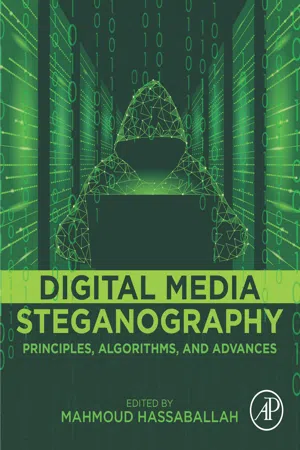
Digital Media Steganography
Principles, Algorithms, and Advances
Mahmoud Hassaballah
- 386 pages
- English
- ePUB (adapté aux mobiles)
- Disponible sur iOS et Android
Digital Media Steganography
Principles, Algorithms, and Advances
Mahmoud Hassaballah
À propos de ce livre
The common use of the Internet and cloud services in transmission of large amounts of data over open networks and insecure channels, exposes that private and secret data to serious situations. Ensuring the information transmission over the Internet is safe and secure has become crucial, consequently information security has become one of the most important issues of human communities because of increased data transmission over social networks. Digital Media Steganography: Principles, Algorithms, and Advances covers fundamental theories and algorithms for practical design, while providing a comprehensive overview of the most advanced methodologies and modern techniques in the field of steganography. The topics covered present a collection of high-quality research works written in a simple manner by world-renowned leaders in the field dealing with specific research problems. It presents the state-of-the-art as well as the most recent trends in digital media steganography.
- Covers fundamental theories and algorithms for practical design which form the basis of modern digital media steganography
- Provides new theoretical breakthroughs and a number of modern techniques in steganography
- Presents the latest advances in digital media steganography such as using deep learning and artificial neural network as well as Quantum Steganography
Foire aux questions
Informations
Introduction to digital image steganography
bLuxor University, Faculty of Computers and Information, Department of Computer Science, Luxor, Egypt
cUniversity of Jeddah, College of Computer Science and Engineering, Department of Computer Science and Artificial Intelligence, Jeddah, Saudi Arabia
Abstract
Keywords
1.1 Introduction

Table des matières
- Cover image
- Title page
- Table of Contents
- Copyright
- List of contributors
- About the editor
- Preface
- Acknowledgments
- 1: Introduction to digital image steganography
- 2: A color image steganography method based on ADPVD and HOG techniques
- 3: An improved method for high hiding capacity based on LSB and PVD
- 4: An efficient image steganography method using multiobjective differential evolution
- 5: Image steganography using add-sub based QVD and side match
- 6: A high-capacity invertible steganography method for stereo image
- 7: An adaptive and clustering-based steganographic method: OSteg
- 8: A steganography method based on decomposition of the Catalan numbers
- 9: A steganography approach for hiding privacy in video surveillance systems
- 10: Reversible steganography techniques: A survey
- 11: Quantum steganography
- 12: Digital media steganalysis
- 13: Unsupervised steganographer identification via clustering and outlier detection
- 14: Deep learning in steganography and steganalysis
- Index